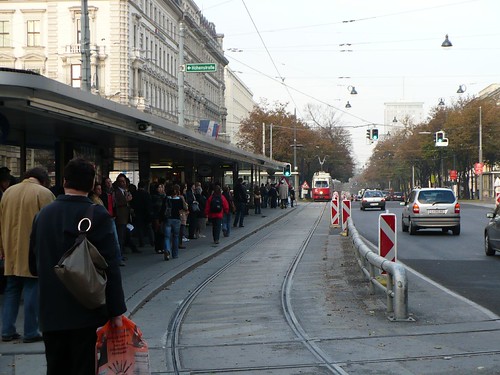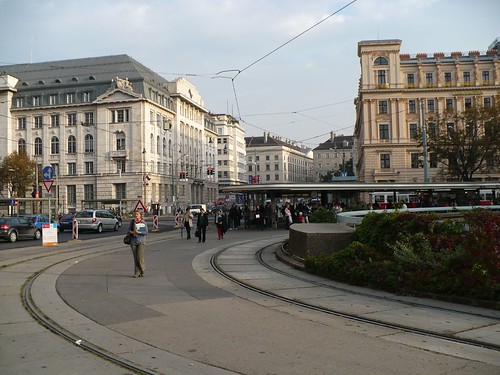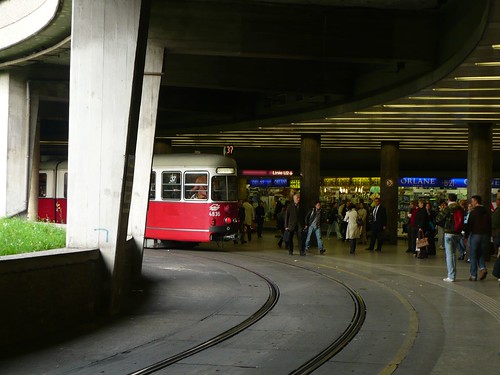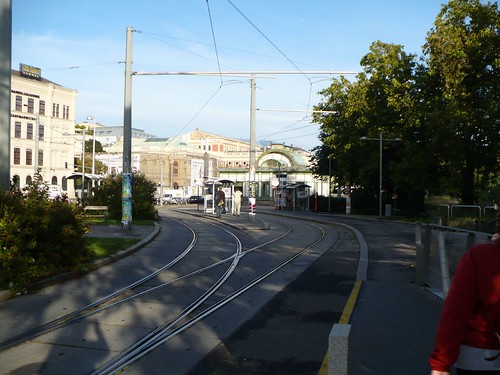
What is the history of this tram ring that allows the circulation of this signature street? Initially the ring was the city fortifications. However Franz Joseph, the King of the Austrio-Hungarian Empire decided that it wasn’t needed anymore and wanted to create a signature street. And create a meaningful place he did. The street is very wide and accommodates automobiles, streetcars, as well as a wide tree lined pedestrian and bike space.
The most interesting piece related to transit is not really the loop itself, although its an important part of both Vienna and Budapest transport, but rather the multimodal connections that are made at certain nodes along the Ringstrasse. At one node, there are four tram stops on the surface, a tram turnaround just beneath the surface and a connection to the M2 Metro which follows its own ring around half of the downtown. In the photos below you can kind of see how this works.





In another node, there are loops for trams, buses and the Metro connected by tunnels which allow citizens to not cross the Ringstrasse on the surface. Underneath the surface its like a mini-mall with eateries and the infamous Tabak shops where you can buy cigarettes and your metro pass.
So why do these systems work? Well first off they are the circulators for all modal connections with in the central city. Their operation is dependent on the interface of faster Metro lines and slower tram and bus connections (the photo below is a tram and bus stop). In Vienna specifically the buses sometimes are even using the tram right of way and stops of the trams. They also all connect to the intercity trains on the edges of town allowing anyone living in town to get around effortlessly without a car.

This means that its incredible affordable to live in the old parts of Vienna. I was told that inside the ring is expensive, but just outside of the ring you can get a nice flat for $600 per month. I will warn folks that there are lots of good restaurants there so food could get expensive.
And if you're worried about the environment, there are people there to remind you.


6 comments:
Until very recently (Google says October), the 1 and 2 tram lines did complete a full lap along the Ringstrasse, one clockwise and the other counterclockwise. People found it an excellent way to look at all the various feats of architecture abutting the Ring, in some thirty or sixty minutes, hopping off to investigate whatever seemed interesting.
So, they get off outside of downtown and use circulators or their own two feet to get to work, unless they choose to transfer to the Metro?
If they work downtown yes. The ring is about a mile across, the furthest being a half mile from the ring at anytime. The metro has a station in the exact center.
I enjoyed using the Vienna metro/trams. I visited there many years ago, and the person I was staying with explained that they used proof of purchase randomised checking. By watching the random inspections my friend had worked out the probabilities of getting caught and decided that for the convenience of not having to muck around with the ticket machines he was willing to pay the fine.
So we went for a trip and I said, I'm not entirely keen on not paying because I always have terrible luck, and a single fine was more than I could afford. But we had a deal when I suggested if he believes in it, he can pay my fine and I'll buy him a ticket's worth of coffee or something.
So we hopped on a metro train, and wouldn't you know it, ticket inspectors. We played the dumb tourist gambit, and it turned out that they didn't speak English, and we got off without a fine. Needless to say, I bought all my tickets after that :)
To Ivo P. (if I can decode correctly), the change of Nos. 1 and 2 in routing, though still (partly) using the Ringstrasse was on October 26th. I've had a following for this, and Vienna is one of my favourite examples. The metro (U-Bahn) looks interesting as well. U6 is actually light rail, by the way, and the trains are LRVs. The "blue tram" is the Badner Bahn, an interurban-y line to the nearby town of Baden, for a length of 30 km.
My favourite of the photos is the second photo. I've got a photo like that on my computer. It's at Schottentor, and I've heard about the five lines to the northwest all terminate there on a loop in a tunnel, as seen in the fifth photo.
In the seventh photo, that's at Karlsplatz. The entrance to the U-Bahn station is historic, with its forerunner being the "Stadtbahn", and is designed by architect Otto Wagner!
Here in Ontario, while I prefer to use the term "interurban", we call these "radial railways".
I also enjoyed the trams but even walking on the ringstrasse was not onerous. I tried to cover all the theatres, galleries and other important centres, and didn't quite make it of course. But there is always next time :)
thanks for the link
Hels
Art and Architecture, mainly
Post a Comment